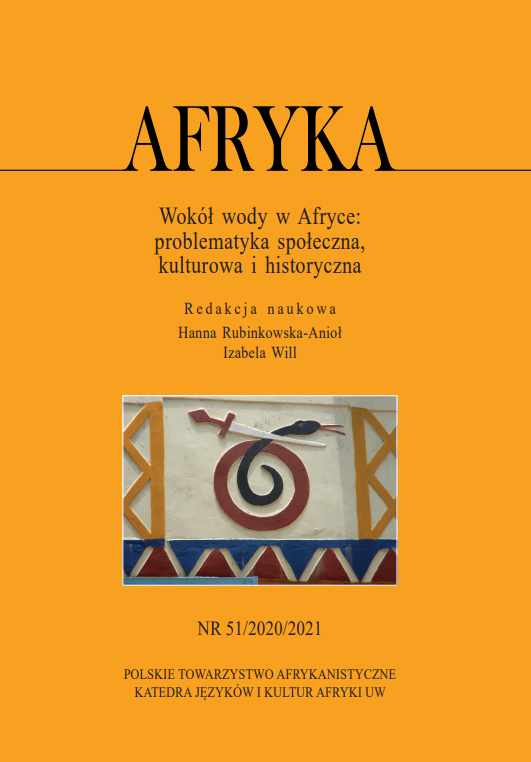Artykuły
Abstrakt
Celem artykułu jest przedstawienie znaczenia budowy tam i zbiorników wodnych w polityce ostatniego Cesarza Etiopii Hajle Syllasje I, zwłaszcza propagandowego wymiaru tej działalności. Artykuł ukazuje działania cesarza w szerszym historycznym kontekście, nawiązując również do kolejnych okresów po upadku Cesarstwa, przez co stara się dowieść ciągłości znaczenia problemu wykorzystania wody w etiopskiej polityce. Jako podstawowe źródło wykorzystane zostało wydawane za panowania Hajle Syllasjego czasopismo „Ethiopia Observer”, które promowało pozytywny obraz zmian zachodzących w tym okresie w Etiopii.
Bibliografia
- „Address of Emperor Haile Sellassie when inauguraiting Koka Dam”. 1960. Ethiopia Observer 4, 8, 247–248.
- Ahmad, Intikhab. 2018. „The new hydro-political situation in Africa”. World Affairs: The Journal of International Issues 22, 4, 60–75.
- Asiedu, Michael. 2018. „The Grand Ethiopian Renaissance Dam (GERD): Ethiopia, Egypt and Sudan push for cooperation”. Global Political Trends Center 15, 1–6.
- Belete Belachew Yihun. 2014. „Battle over the Nile: The diplomatic engagement between Ethiopia and Egypt 1956-1991”. Journal of Ethiopian Studies 8, 1&2, 73–100.
- „[The] Blue Nile”. 1959. Ethiopia Observer 3, 1, 20–21.
- „[The] Bounty of the Awash”. 1960. Ethiopia Observer 4, 8, 246.
- Caulk, Richard. 2002. „Between the jaws of hyenas”: A diplomatic history of Ethiopia (1876–1896). Wiesbaden: Harrassowitz Verlag.
- „Charissimo in Christo filio Zarajacob Regni Aethiöpiae illustri salutem”. 2005. Lettere Tra I Pontefici Romani E I Principi Etiopici (Secc. XII–XX). Verrsioni E Integrazioni, red. Osvaldo Raineri. Città del Vaticano, 36.
- Davis, Mary. 2010. „Pankhurst, Estelle Sylvia”, w: Alessandro Bausi, Sigbert Uhlig et al. (red.), Encyclopaedia Aethiopica, tom 4. Wiesbaden: Harrassowitz Verlag, 109–111.
- Dębowska, Magdalena. 2019. „Dolina Omo u progu społecznych i ekologicznych przemian”. Afryka 49, 1–18.
- „Ethiopian Industry from 1941”. 2014. w: Alessandro Bausi et al. (red.), Encyclopaedia Aethiopica, tom 5. Wiesbaden: Harrassowitz Verlag, 351–354.
- „Ethiopia’s First Five-year Plan”. 1959. Ethiopia Observer 3, 4, 106–135.
- [The] Federal Democratic Republic of Ethiopia, Ministry of Water Resources. 2001. Ethiopian Water Sector Strategy. dostępne na: http://extwprlegs1.fao.org/docs/pdf/eth165069.pdf, dostęp z dnia 5 października 2021.
- Fekade Azeze. 2005. „Ethiopia Observer”, w: Sigbert Uhlig et al. (red.), Encyclopaedia Aethiopica, tom 2. Wiesbaden: Harrassowitz Verlag, 401–402.
- Gascon, Alain. 2010. „Qoqa”, w: Alessandro Bausi, Sigbert Uhlig et al. (red.), Encyclopaedia Aethiopica, tom 4. Wiesbaden: Harrassowitz Verlag, 299–230.
- Howell, Paul; Michael Lock; Stephen Cobb (red.). 1988. The Jonglei Canal: Impact and opportunity. New York: Cambridge University Press.
- Hydro Rewiev. 2016. dostępne na: https://www.hydroreview.com/2016/12/15/6-6-mwaba-samuel-hydropower-plant-returned-to-ethiopia-following-completion-of-work-bychinese/#gref, dostęp z dnia 7 grudnia 2020.
- International Crisis Group. 2021. Containing the Volatile Sudan-Ethiopia border dispute. Brussels: International Crisis Group.
- Joesten, Joachim. 1960. „Nasser’s daring dream: The Aswan High Dam”. The World Today 16, 2, 55–63.
- Kliot, Nurit. 1994. Water Resources and Conflict in the Middle East. New Yourk: Routledge.
- Kloos, Helmut. 1982. „Development, drought, and famine in the Awash Valley of Ethiopia”. African Studies Review 25, 4, 21–48.
- Krebs, Verena. 2019. „Crusading threads? Ethiopian-Egyptian relations in the 1440s”, w: Benjamin Weber (red.), Croisades en Afrique: Les expéditions occidentales à destination du continent africain, XIIIe – XVIe siècles. Toulouse: Presses universitaires du Midi Méridiennes.
- Marcus, Harold G. 1963. „Ethio-British megotiations concerning the western border with Sudan, 1896-1902”. The Journal of African History 4,1, 81–94.
- McCann, James. 1981. „Ethiopia, Britain, and negotiations for the lake Tana Dam, 1922–1935”. The International Journal of African Historical Studies 14, 4, 667–699.
- Mekonnen Ermias. 2019. „Surface water and groundwater resources of Rift Valley Lakes Basin of Ethiopia: A review of potentials, challenges and future development perspectives”. International Journal of Recent Development in Engineering and Technology 8, 6, 4–10.
- Milas, Seifulazis. 2013. Sharing the Nile. Egypt, Ethiopia and geo-politics of water. London: Pluto Press.
- Müller-Mahn, Detlef; Million Gebreyes. 2019. „Controversial connections: The water-energy-food nexus in the Blue Nile basin in Ethiopia”. Land 8, 135, 1–20.
- Noer, Thomas J. 1984. „The new frontier and African neutralism: Kennedy, Nkrumah, and the Volta River Project”. Diplomatic History 8, 1, 61–79.
- Pankhurst, Richard. 1966. „Some notes for a history of Ethiopian secular art”. Ethiopia Observer 10, 1, 5–80.
- Pankhurst, Richard and Rita. 2013. Ethiopian reminiscences: Early days. Los Angeles: Tsehai Publishers.
- Pankhurst, Sylvia. 1959. „Zula Dam – Its geographical and historical background”. Ethiopia Observer 3, 8, 238–242.
- Rubinkowska-Anioł, Hanna. 2018. „Ethiopian Renaissance or how to turn dysfunctional into functional”. Politeja 5, 56, 109–121.
- Selected speeches of His Imperial Majesty Haile Selassie First 1918 to 1967. 1967. Addis Ababa: The Imperial Ethiopian Ministry of Information.
- Smidt, Wolbert. 2007. „Nile”. w: Sigbert Uhlig et al. (red.), Encyclopaedia Aethiopica, tom 3. Wiesbaden: Harrassowitz Verlag, 1177–1181.
- Tadesse Kassa Woldetsadik. 2013. International watercourses law in the Nile River Basin. Three states at a crossroads. London: Routledge.
- Tadesse Kassa Woldetsadik. 2014. „Anglo-Ethiopian Treaty on the Nile and Tana Dam concessions: A script in legal history of Ethiopia’s diplomatic confront (1900–1956)”. Mizan Law Review 8, 2, 271–298.
- US Bureau of Reclamation. 1958. Studies of the Abay River water resources. Denver: US Bureau of Reclamation.
- Verhoeven, Harry. 2013. „The politics of African energy development: Ethiopia’s hydro-agricultural state-building strategy and clashing paradigms of water security”. Philosophical Transactions: Mathematical, Physical and Engineering Sciences 371, 2002, 1–16.
- Verhoeven, Harry. 2015. Water, civilisation and power in Sudan. The political economy of military-Islamist state building. New York: Cambridge University Press.
- Vestal, Theodore M. 2003. „Emperor Haile Selassie’s First state visit to the United States in 1954: The Oklahoma interlude”. International Journal of Ethiopian Studies 1, 1, 133–152.
- Warner, Jeroen. 2011. Flood plann ing: The politics of water security. London: I.B. Tauris.
- Wossenu Abtew; Shimelis Behailu Dessu. 2018. The Grand Ethiopian Renaissance Dam on the Blue Nile. New York: Springer.
- Zeray, Yihdego; Alister Rieu-Clarke; Anna Elisa Cascão (red.). 2018. The Grand Ethiopian Renaissance Dam and the Nile Basin. Implications for tansboundary water cooperation. London: Routlege.
